为什么网络摄像头不够好
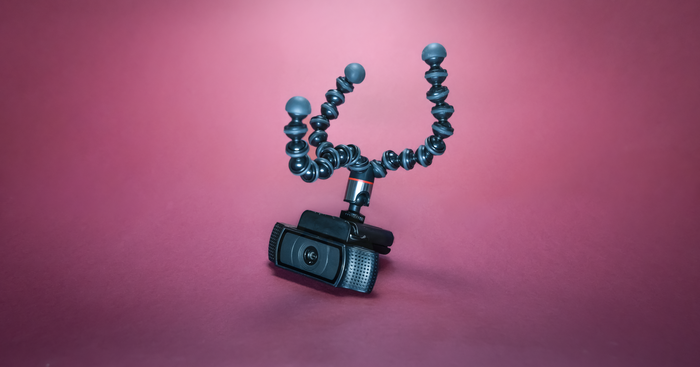
在咨询了许多网络摄像头购买指南和评论,购买了一些最受欢迎的型号并在不同的光照条件下对其进行了测试之后,我无法逃避这个残酷的事实:没有好的网络摄像头。即使是信誉卓著的网店推荐的网络摄像头,也会产生质量较差的图像,这是一项重大失败,因为这是他们应该提供的一项工作。
颜色不均匀。突出显示。细腻的细节,尤其是在弱光下。任何负担得起的网络摄像头(即使是负担得起的高端产品,价格也要超过100美元),都使用了性能不佳且通常使用已久的硬件,而这些硬件通常由平庸的软件支持,这实际上使您看起来很糟糕。如果您使用的视频软件会使自己的图像变小,那么您可能不会注意到这一点,但是在通话中的其他人会很明显。
亲自看看:下面的视频同时显示了在相同条件下同时使用市场领先的网络摄像头(C920,Kiyo和Brio)以及iPhone的基准。
- 罗技 C920 存在许多问题,最明显的是曝光问题。
- 罗技 Brio 努力跟上运动,似乎正在应用皮肤平滑过滤器。
- iPhone Pro 可提供出色的画质、自然的色彩,并且是唯一不为对焦而苦恼的选择。
为什么网络摄像头是这样的?毕竟,自从目前“最好的”网络摄像头投放市场以来,小型摄像头技术已呈指数级提高,但这一切都发生在我们的手机中。为了说明这一点,我将最流行的网络摄像头与Camo进行了对比,该软件利用了iPhone,iPad和iPod touch的摄像头和成像技术,使您的外观明显好转。即使没有出现Camo,但仍然缺少顶级网络摄像头的输出。
对它们进行测试
为了进行测试,我收集了一组最受好评和最畅销的独立网络摄像头,以及一个便宜的仿冒产品模型(我会让你猜是哪一个)。显示的数字是公司的建议零售价:
- 罗技 Brio 4K Pro(199 美元)
- 罗技 StreamCam(169 美元)
- 罗技 C920(80 美元)
- Adwaita 8 MP 超高清 4K 网络摄像头(50 美元)
相比之下,我收集了一些运行Reincubate Camo的iPhone,包括我能找到的最旧的支持机型。该应用程序可以在运行iOS 12或更高版本的任何设备上运行,包括iPhone 5s和iPod touch 6:
- iPhone 11 Pro(我的日常手机,999美元)
- iPhone SE(2019型号,399美元)
- iPhone 6(2015年,我以90美元的价格购买了二手并解锁的2020年秋季)
最新的iPhone型号显然比网络摄像头贵,但它们的作用还不仅仅在于充当相机。尽管我不排除会出现这种情况,但我怀疑有人会购买仅用作网络摄像头的新iPhone。更有可能的是,有人会使用自己的主电话,重新使用不再使用的旧型号或购买二手型号。测试是在16英寸MacBook Pro(2019型号)上完成的。
照片上的一些注意事项:除非特别说明,否则图像是使用网络摄像头的默认设置捕获的。 iPhone是使用Camo连接的,但未使用该应用程序的调整工具。您所看到的就是相机提供的东西。
捕获它们的房间位于部分暴露的地下室,地下室有两个窗户和浅黄色的墙壁。房间的照明包括一个吊顶灯具和一个装饰吊灯,吊顶灯具带有出售为5000K日光的家用LED灯泡。换句话说,这是一个非常典型的房间,可以在家工作和参加视频会议。
我还设置了一对外部15.4英寸Dazzne桌面安装LED视频灯,以提供更多照明,尤其是在夜间拍摄时。我注意到打开了哪些照片。正如我将在后面讨论的那样,不可低估拥有足够可用光线的重要性,它适用于此处讨论的所有网络摄像头。
由于Zoom已成为视频会议的事实上的标准,因此在非公开会议中可以在Zoom中查看视频供稿。缩放和其他服务有时会限制广播分辨率以优化所使用的带宽量,因此通话另一端的人可能看不到与您相同的图像质量。在我的测试中,“私人通话缩放”的性能与在QuickTime Player中观看视频源(选择“文件”>“新电影录制”)不具有流功能相当。
最后,放置:所有摄像机都设置在我的笔记本电脑屏幕上方,以方便在它们之间切换,因此您会看到每种型号的角度略有不同。这次我并不是专注于完美的构图。

在进行特定网络摄像头比较之前,让我们重点介绍一些普遍问题。
第三方网络摄像头问题
每个测试的网络摄像机都有其独特的方式,但总的来说,以下故障最为明显。
曝光问题和热点:网络摄像头的首要任务是自动考虑场景中的照明并相应地调整亮度。为了确保位于画面中央的物体(即您)光线充足,相机通常会在其他地方增加亮度。这种推理是可靠的,但是如果有窗户或灯在射中,它很可能会吹成纯白色,并分散观众的注意力。即使在看起来光线充足的房间里,光线也会洒到您身上并且过度曝光诸如额头或che骨之类的特征,这也不罕见。尽管我每次都会在曝光不足的情况下拍摄一个明亮的场景(出于某些原因),但是热点和过度曝光只会分散注意力。
![使用 8 年的罗技 C920 仍然以某种方式被推荐为最好的网络摄像头之一。 The 8-year-old Logitech C920 is still somehow recommended as one of the best webcams.]()
使用 8 年的罗技 C920 仍然以某种方式被推荐为最好的网络摄像头之一。 颜色问题和白平衡:另一个需要自动调节的网络摄像头需要注意的是色彩保真度,而这与曝光一样成问题。从观看者的角度来看,白平衡(也称为色温)决定了您看起来冷淡还是橙色。我真的像我看起来一样红润吗?哎呀,那是我的肤色吗?答案常常是“否”。
![比较中最昂贵的网络摄像头罗技 Brio 倾向于粉红色。 The Logitech Brio, the most expensive webcam in this comparison, tends toward pink hues.]()
比较中最昂贵的网络摄像头罗技 Brio 倾向于粉红色。 焦点问题:我看过的所有网络摄像头都提供自动对焦,以使主体保持清晰,除了一台具有固定焦点范围的廉价无名相机(或者,在市场营销方面,“固定焦点以保持一致的景深”,意思是“离相机足够远,以至于您处在最佳位置”)。有些相机在实现自动对焦方面做得很差,而另一些则动作缓慢。如果您说话时倾向于移动,则网络摄像头可以“反弹”,因为它锁定焦点,丢失焦点然后再次找到它。再次,分散注意力。
![此次比较中最新的网络摄像头是罗技 StreamCam。 The newest webcam in this comparison is the Logitech StreamCam.]()
此次比较中最新的网络摄像头是罗技 StreamCam。 图像柔和度:自动对焦差会导致图像柔和,但这不是唯一的罪魁祸首。有些相机只是不保留您希望看到的细节,或者它们似乎在对皮肤进行平滑处理。
![我用 Brio 拍摄的皮肤纹理更类似于在某些视频会议软件中打开“修饰我的外观”设置。 The texture of my skin here, shot with the Brio is more akin to turning on the "Touch Up My Appearance" setting in some video-conferencing software.]()
我用 Brio 拍摄的皮肤纹理更类似于在某些视频会议软件中打开“修饰我的外观”设置。 弱光性能:诚然,对于任何相机来说,弱光情况都是困难的,网络摄像头使用各种方法来处理它。但是,由于多种原因,当光线不足时,网络摄像头通常会很糟糕。或者,当网络摄像头认为光线不足时,我应该说。
- 稀缺性和价格欺诈:由于突然转移到远程工作和学校,即使是这些所谓的“优质”网络摄像头也仍然很难找到,并且以高价出售。另一种选择是赌博大量的无名克隆。
- 软件:用于进行手动调整以覆盖自动设置的控件不充分,令人困惑或不存在。例如,用于控制Logitech StreamCam独有的某些功能的应用程序Logi Capture的macOS版本最高为2.02版,但仍处于beta版(我有崩溃来证明这一点)。
- 电子垃圾:不符合预期的设备会发生什么?它们最终放在抽屉或垃圾填埋场(或先是抽屉然后是垃圾填埋场)中,或散装到世界各地被撕碎并回收利用。 (去年产生了5,360万吨的电子废物。)并且不要忘记首先将网络摄像头放入该抽屉的包装,运输材料和运输成本。
- 音频:每个独立的网络摄像头均包含一个或多个麦克风,以不同的能力水平捕获音频。我不在这里分析其音频,因为您最好购买便宜的USB麦克风,甚至使用手机随附的耳塞来获得更好的音频质量。
- 处理器负担:实时捕获,编码,解码和流式传输视频是处理器密集型任务。在iPhone上,专用硬件处理大量工作,包括渲染图像和处理视频,这些任务均来自手机的主处理器。但是,独立的网络摄像头只能将信号推送给计算机处理。 Logitech曾经提供过硬件编码器,但是这些已经逐步安静地淘汰。
现在,让我们详细了解每个网络摄像头。
最受欢迎的网络摄像头中存在重大缺陷
罗技C920
当C920通常被认为是对大多数人来说最好的网络摄像头时,我开始怀疑是否有人在进行大规模的恶作剧,因为这与我亲眼所见不符。即使在光线充足的情况下,C920本身也会遭受可怕的过度曝光,白平衡差和对焦模糊的困扰。
实际上,当我增加光面板的功能时,您会看到相机正在努力进行补偿:减少了曝光,但随后又跳回了原处,就好像它旨在确保在任何地方都存在爆破区域一样成本.C920试图平衡照明,但无法做到这一点。
罗技C920与iPhone 6自拍
好吧,让我们做一个最差的比较。对于大多数网络摄像头,添加更多的光线可以改善图像;一方面,向对象添加大量前景光会触发它们减少背景的曝光。但是,C920只能看到更多的光线,并且继续过度曝光。白平衡全部关闭,使整个场景降低饱和度。
在iPhone产品阵容中,iPhone 6的前置Selfie相机在纸张上性能最差,并且表现最差。窗户和我的脸都被炸得很厉害,但是白平衡和对比度比C920的输出要好得多。当然,这不是我的第一选择,但至少我看上去并不绿色。
罗技Brio
Brio的突出特点是其4K分辨率,能够以3840 x 2160像素进行记录。这听起来不错,因为我们受过训练,认为“ X越多越好”,其中X等于分辨率,兆像素,千兆字节,千兆赫兹和所有其他技术规格。但是,较高的分辨率会有所折衷。
分辨率背后的总体思路是,记录的像素更多,您可以查看更多的细节并最终获得更清晰的图像。早期的高清摄像机以720p分辨率(1280 x 720像素)记录;现在,YouTube甚至没有将其HD标签应用于1080p(1920 x 1080像素)以下的任何物体。 4K(3840 x 2160像素)分辨率现在在电视上很普遍(8K开始在陈列室和在线零售商中流行)。
高分辨率的困难在于处理需求的增加:实时捕获和处理每帧200万像素(1080p)所需的处理能力要比每帧900,00像素(720p)高(两个数字均舍入)。 4K每帧需要推动近830万像素。视频编码方案将数据压缩到更易于管理的水平,但是由于摄像机不包含专用的编码硬件,因此工作由计算机的处理器执行,这给系统带来了更大的压力。
要将Brio设置为以4K模式记录,您需要运行单独的Logitech Capture程序。在不到一岁的MacBook Pro上,切换到4K会导致明显的延迟(最长4秒),使视频聊天无法进行。另外,要使4K流进入视频会议软件,您需要指定Logitech Capture作为视频源。但是出于我们这里的目的,更重要的考虑因素是带宽,因为4K实时流是进入管道的大量数据,这些数据会由托管服务的公司自动压缩并在传输过程中减少。因此,最终,除非您要录制本地内容,否则将浪费4K。

如前所述,Brio最明显的问题是如何吹出明亮的区域,奇怪地渲染颜色以及如何使皮肤光滑。
在正常或非常弱的光线下,Brio图像会变得嘈杂并失去细节。它包括Logitech称为Rightlight 3或“ Rightlight 3 with HDR”的功能,旨在更好地平衡增益和噪声。但是,在Mac版本的Logitech设置软件中,没有任何提及Rightlight的功能,只有一个HDR开关在打开时的影响很小。该硬件还包括一个红外传感器,该传感器仅在Windows 10下具有Windows Hello解锁功能。
我可以在场景中投出的光越多,获得的质量就越好,尤其是在细节方面。这意味着将视频灯的亮度提高到65%,亮度足以使我起眼睛,感觉就像在工作室一样。我很难相信大多数人会创建这样的设置来召集工作会议。
为了在右边创建图像,我不得不将视频灯调高65%,对于大多数人来说,这不是一个理想的解决方案,或者我认为是通用的解决方案。
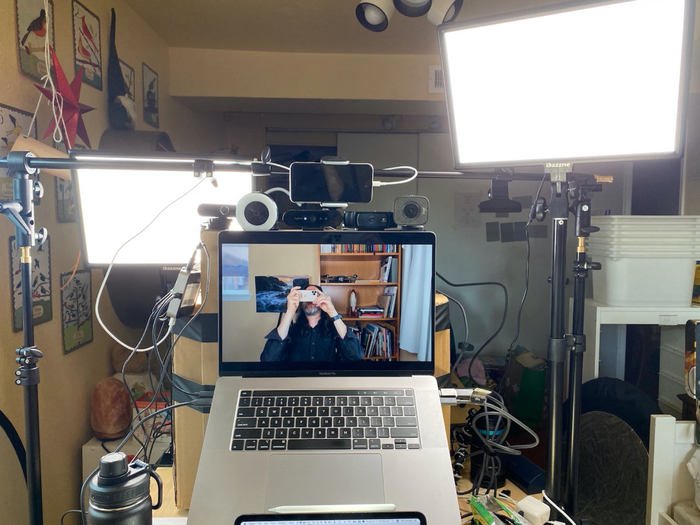
罗技Brio与iPhone 6
上一张照片的一个重要特征是场景中有多少光。在我们看来,窗光所照亮的日光场景看起来很自然。但是对于相机而言,场景曝光不足,这可能是为什么上面的Brio镜头有些暗淡且缺少阴影细节的原因。向前景添加更多的光会有很大的不同。
为了进行下一个比较,我以面对我的方式打开了视频灯,其输出功率约为最大输出的10%,色温设置为5000K(以匹配天花板灯泡的温度,尽管房间的照明灯已关闭)。尽管窗口仍然是白色矩形,但Brio的图像肯定比以前的图像好(但是这次有一些暗示,表明外面有东西)。尽管胡须中的清晰度仍然模糊,但我脸上的高光效果更好。有了更多的光线,我们还可以看到皮肤看起来更光滑,并带有奇异的粉红色。整体白平衡得到改善。
在相同照明条件下与Brio对抗的是2019年的iPhone SE(非正式称为iPhone SE 2)。色彩平衡更好,窗口中的清晰度更高(尽管它仍然大部分被吹掉了),胡须看起来也更粗糙。我的脸看起来有点红。
增加灯板的功率有很大的不同;这些照片让您感觉相机处在更舒适的环境中。我们在Brio的照片中透过窗户看到了一些细节,我脸上的光线更加平衡,背景色看起来更好。但是,我的脸看起来甚至更粉红色,并且经过处理。 iPhone SE的图像也有了很大改善。尽管我的脸看起来仍然有些过饱和,但是我的皮肤和胡须有更多可见的质感,并且总体而言颜色更好。
罗技Brio 4K Pro与iPhone 11 Pro
这些照片是仅使用从图片左右边缘的窗户射入的光线拍摄的。那是一个有雾的早晨,所以光线自然扩散了。在Brio图像中突出的区域是左侧完全吹开的窗口,并且总体上总体上是模糊的图像质量。在这种情况下,我的盐和胡椒胡须很有帮助,因为在这种情况下,它表明相机将头发束成像素化的团块。颜色也被静音,将黄色的墙壁变成蛋壳状。
在来自iPhone 11 Pro广角镜的图像(默认为“ 1x”视图)中,窗口中有定义。实际上,您可以看到它是一个窗户,并在外面找出甲板和围栏。 (这是由于iPhone进行了连续的HDR处理。)我脸上的颜色看起来更自然(如果有点红),并且来自框架右侧的光线有很好的阴影细节。白平衡在iPhone版本中更好:墙壁是浅黄色的正确阴影,窗框和书架上的书本等白色区域看起来是白色的,而不是太热或太凉。
Brio还具有HDR选项,您可以使用Logitech Capture应用程序(免费下载)启用或禁用该选项,该选项可让您配置设置。但是,该功能基本上没有用。

罗技StreamCam
考虑到StreamCam是其中的最新款网络摄像头,我期望与其他Logitech型号相比,图像质量会有更多改进。但是,它也存在许多相同的问题:爆裂的白色,即使在适度的光线下也具有令人惊讶的柔和图像,以及某些皮肤平滑的外观。相机的f / 2.0镜头可提供额外的光线,但似乎并没有太大的不同。 StreamCam感觉像是Brio的非4K版本,如果您将Logitech Capture与其一起使用,则会具有一些功能。
这些功能不足以达到我们的目的。 StreamCam包含一个指示其处于横向还是纵向模式的传感器-在大多数应用程序中以横向视频显示。它还包括图像稳定功能……适用于已安装且无法移动的相机。一种可能有用的功能是自动取景,该功能(以数字方式)放大您的脸部并在您移动时重新构图,同时保持脸部居中。串流视频游戏时,在一个小窗口中跟踪人脸可能会很好,但实际上,它令人不安,并且会引起人们对摄像机运动而不是主体的注意。
罗技Streamcam与iPhone 6
在比较中,我将2020年2月发布的最新网络摄像头与最古老的iPhone机型2015年发布的iPhone 6进行了比较。
同样,使用独立的网络摄像头,我们可以看到后面的窗口全是白色的,另一个窗口的光也吹到了我的脸侧。颜色被静音了,胡须里没有太多的清晰度。实际上,我看起来有点失焦。
iPhone 6版本的5年相机存在一些相同的问题。窗户被炸开,阴影相当暗。但是,我脸部侧面的高光更加受控制,白平衡更好,而且对我而言,对比度的提高使图像更具深度。 iPhone 6的图像不如iPhone 11 Pro,但后者的摄像头和成像技术比iPhone 6的唯一后置摄像头先进了几个数量级。
Adwaita 4K USB 2.0网络摄像头
我不能说这种廉价的4K网络摄像头是否能代表市场,但是基于许多其他消费电子设备的模式,我怀疑有几家公司使用相同的组件并对其产品进行品牌重塑。该设备的镜头比大多数人更窄,只有5.6mm,这意味着您最终会在框架内被裁剪(或者需要将网络摄像头移得离您更远)。
正如我之前所讨论的,图像传感器能够捕获4K视频,该分辨率对于视频会议没有意义。图像呈颗粒状,尽管在低光照条件下提供细节方面比其他网络摄像头做得更好,但是白平衡通常不可用。 Adwaita镜头是固定焦点。
Adwaita 网络摄像头不提供设置软件,将其留给您正在使用的任何捕获应用程序(如果此类控件可用)。
专业人士使用什么
暂时搁置成本和可用性问题,最好的摄像头是让您的通话获得出色视频的最佳相机?仅需$ 15,000,您就可以进入RED摄像头系统的地面层,然后从那里向上行驶。
更现实的是,许多视频创作者使用具有较大图像传感器的DSLR或无反光镜相机(例如Sony的Alpha系列) ,并搭配具有大光圈(因此景深浅)的高质量镜头,以更好地控制光线和背景的柔和度。这些代表着大约600美元的投资,根据机身,镜头和诸如HDMI采集卡之类的硬件,可以将它们全部连接到计算机的价格可能高达数千美元。
但是,根据您在视频通话中展示自己的方式而定,这可能是过高的费用。如以下视频所示,iPhone机型中的技术已经可以提供令人难以置信的质量水平。
将iPhone用作网络摄像头很容易成为最佳选择,而不会花费超过1,000美元购买专业相机装备。使用您已经拥有的iPhone,或者最近放手一搏,在照明上进行适度的投资,以及Reincubate Camo,您将获得出色的效果,并且不会带来独立网络摄像头带来的挫折和麻烦。
为什么网络摄像头如此糟糕? (以及为什么他们永远都不会改善)
多年来,网络摄像头公司在使用陈旧且因此成本较低的组件方面做得很好。尽管C920于八年前于2012年首次推出,但它仍然被认为是市场上最好的网络摄像头之一。Brio和Razer Kiyo于2017年问世,StreamCam于2020年初问世,您可以在上面看到结果。
当前有两个主要因素阻碍了严重的网络摄像头创新,一个是技术限制,另一个是业务缺陷。
与所有摄影一样,创建更好的图像的方法是捕获更多的光,而捕获更多的光的方法是使用更大的图像传感器和更大的镜头。这就是消费类数码单反相机或无反光镜相机产生比网络相机更好的图像的原因。
主要是关于尺寸:网络摄像头被设计为小型设备,需要安装在现有的显示器或笔记本电脑的盖子上,因此它们使用带有小型图像传感器的小型摄像头模块。这些模块已经足够好多年了,并产生了赞誉,因此几乎没有动力去改变。 StreamCam似乎具有更好的相机和传感器,光圈为f / 2.0;没有列出其他相机的光圈。
将此技术与iPhone进行对比,iPhone还必须包括小型摄像头模块,以使其适合手机尺寸。 Apple包括更好的组件,但同样重要的是,Apple仅将专用的硬件和软件集成到了创建图像的任务中。当您使用iOS设备拍摄照片或视频时,它会处理原始数据并输出场景的编辑版本。
最初,Logitech的高端网络摄像头(例如C920)还包括专用的MPEG处理硬件来对视频信号进行编码,但在某些时候将其删除(不更改型号或以其他方式表示更改,但未注明日期的博客文章除外)。该公司通过现代计算机的强大功能证明了这一改变的合理性,并指出:“如今的计算机不再需要相机内编码”,但这只是将处理负担转移到了计算机的CPU上,后者必须解码原始视频优化流。同样,罗技(Logitech)做出了更改,以降低组件成本,并且不再为获得MPEG LA(拥有MPEG专利的组织)的H.264编解码器支付许可。
这将我们带入了限制网络摄像头创新的另一个因素:制造商没有像过去那样为满足相对较小的客户群而投资于低利润业务。苹果六个月的研发预算超过了罗技的年度总收入,因为苹果意识到iPhone的摄像头可能会带来巨大的竞争优势。






























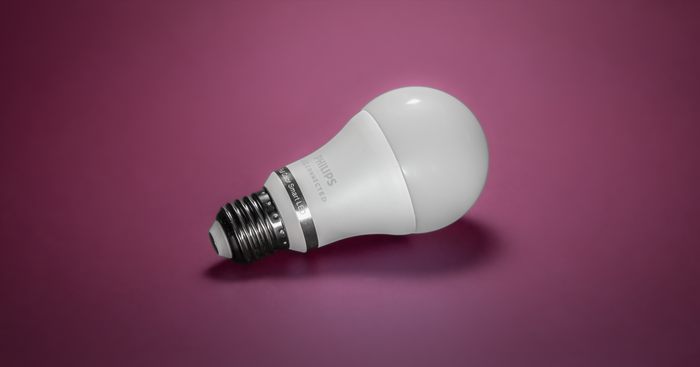
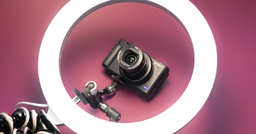
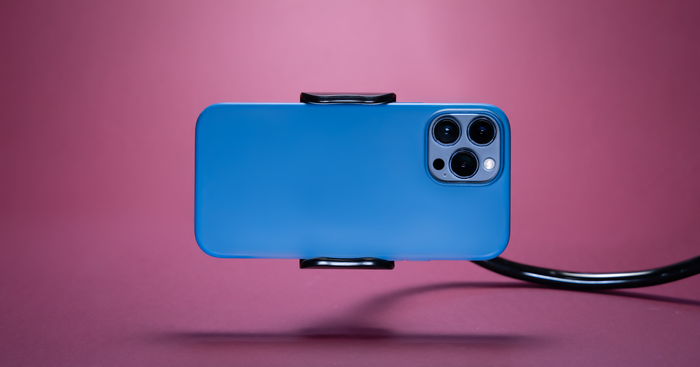

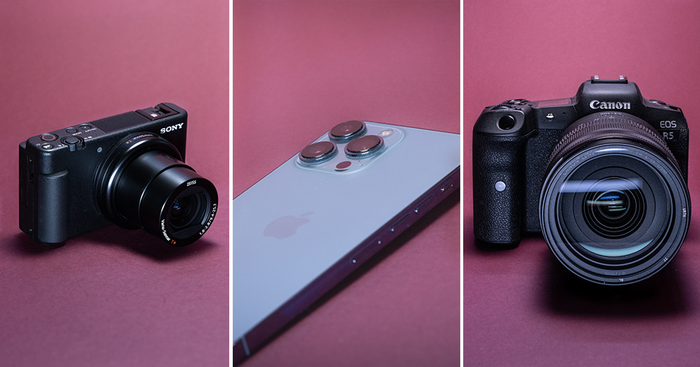

由 Silke
Unfassbar guter Artikel! Und ich hätte ihn so gerne gelesen, bevor ich alle meine Tests gemact hatte:-( Ich habe ein iPhone SE (nutze als Software die Epo Cam Pro) und dachte mir, ich kaufe mir jetzt mal eine ordentliche Kamera. Habe mich dann im Sinne Preis/Leistung für die Logitech C920 entschieden. Und war von Anfang an damit unzufrieden - v.a. wegen der Überbelichtung. Hab dann die Software runtergeladen, in den Einstellungen ohne Ende Varianten ausprobiert und auch in zoom (soweit das möglich ist). Das Ergebnis war: maximal unbefriedigend. So denn: Konsequenz: Logitech 920 schick ich zurück und bleibe bei meine "alten" iPhone SE :-). Positiver Effekt: Günstiger geht es nicht (iphone lag eh bei uns rum). NOCHMAL DANKE AN DEN TOLLEN, AUSFÜHRLICHEN UND VERSTÄNDLICHEN BERICHT! (spart hoffentlich Geld und Material für "sinnlosen" WebCam-Kauf).
由 RobL.
Why is everyone puzzled? Yes I had a 2012 or 2013 laptop, had a great built in webcam. Now they all stink. This is a marketing decision: corporate greed. They decided to built them with cheap cameras, that's all. It either got too expensive (really they found a way to do it cheap, the hell with quality) and everyone is stuck. It's standard operating business procedure. Like food nowadays. They found cheaper and cheaper ways to raise/produce it, so the hell with the quality. And you pay more. Whole Foods did it to its fine quality sirloin and hamburger. You're simply stuck.
由 Monty Cantsin
A parallel story exists for audio: it's impossible to find a device for a computer that uses multiple microphones to actively cancel background noise, like pretty much every flagship phone does. My old Pixel 3 phone had an extra pinhole mic that allowed me to stand next to a lawnmower without the person on the other end of the call noticing. It would subtract out the external noise from the pinhole mic, leaving just my voice coming through clear on the main mic. Not sure why this is so hard for someone to sell as a standalone device.
由 Trean Ducwort
The actual problem lies in the fact that nobody in the actual camera industry makes web camera houses with a good sensor, so you can put any of their lenses on and actually get photographic quality. Sorry but Logitech is not a camera company and their plastic lenses and tiny sensors are still stuck in the 80ies.
由 Daniel D Malone
Great article and detailed. I might add that the video card being used in the computer is also a factor. I didn't see it mentioned but I apologize if I didn't see it.
由 Yann
Great article. I am also very surprised how overrated the c920 is. Also I noticed that the same webcame reacts differently depending on the software: the result using Logitech App is generally correct. Using MS Teams, the image gets blurred without any option to handle it!
由 David Arditti
I bought a Brio, as pretty much the most expensive webcam you can get, hoping it would be a bit better than the cheaper webcams, but it isn't really. Apart from the image quality failings mentioned here, the most frustrating aspect is the software (which I've only tried on a Mac). It continually defaults to a state of terrible over-exposure in the conditions I use it in, and, worse, to 720p. Why on earth do Logitech do this? It should be obvious to them that people buying their most expensive camera will want to normally create HD video, but the software still keeps defaulting to 720p. So all my projects end up with a mixture of 720p and 1080p, when I remember to switch that switch again.
由 Maximilian Cascone
Great article! Can you do baby monitors next? They universally suck.
回复: Reincubate Support
Thank you! Is there a particular monitor you'd like us to look at?
由 Mark P.
Found this via Daring Fireball and just wanted to thank you for this incredibly comprehensive article. Not having a lot of technical knowledge about cameras/video, I ordered the highly recommended Logitech C920 and thought I was going insane when it didn't hold a candle to a quick comparison with my iPhone 8... not to mention pulling my hair out for nearly a full day installing and uninstalling Logitech's various webcam apps before finally realizing the cam worked much better without them.
由 Snoop
Thanks for this lengthy review. I finally understand why that market still looks so bad even today!
This is really absurd and not just because chips got much better for much cheaper but because in a world caught in the middle of the major pandemic, no company came with a great product. It is AMAZING and stupid. Everybody sees everyday how bad the image is... and i can't believe there is no market between a 100$ devices and 2K$ to 15K$.
Do you remember the iSight from Apple introduced in 2003??? The design was great and the quality for the time was excellent compared to competition for a 149$ (cheap for an Apple product). Image quality was great and speed amazing thanks to a FireWire connection (400 Mbit/s in 2003!). I kept it until 2010 or so.
Anyway, I'm puzzled and can't understand why manufacturers don't do something better in this period, honestly.
Thanks again for putting this up!
由 Snoop
Thanks for this lengthy review. I finally understand why that market still looks so bad even today!
This is really absurd and not just because chips got much better for much cheaper but because in a world caught in the middle of the major pandemic, no company came with a great product. It is AMAZING and stupid. Everybody sees everyday how bad the image is... and i can't believe there is no market between a 100$ devices and 2K$ to 15K$.
Do you remember the iSight from Apple introduced in 2003??? The design was great and the quality for the time was excellent compared to competition for a 149$ (cheap for an Apple product). Image quality was great and speed amazing thanks to a FireWire connection (400 Mbit/s in 2003!). I kept it until 2010 or so.
Anyway, I'm puzzled and can't understand why manufacturers don't do something better in this period, honestly.
Thanks again for putting this up!
由 Ben Smith
Thank you for the great article. How would you expect the Mevo Start to compare as a webcam?
回复: Reincubate Support
Good question! We've not benchmarked one yet. Few thoughts:
The comparison videos that Mevo publish make it appear better than any Logitech, but still quite a way under the performance you'd see from a modern iPhone. The videos look saturation-boosted, which tends to make things look great but not always very lifelike. Their webcam app is Mac-only, and still in beta.
The Mevo Start is built around the Sony IMX307, which is a ~$25 (retail, cheaper in bulk) image sensor, so this makes sense: that's a better bit of kit than you'd get in a webcam, but it's not on par with Apple's technology.
由 Dave Barnes
If you were a pundit who appears regularly on cable TV shows (and, therefore has plenty of money) what setup would you buy?
回复: Reincubate Support
That's a big, nuanced question, Dave! Jeff Carlson is hard at work putting together a detailed iPhone vs DSLR & mirrorless comparison piece, and that's going to answer is fully. It should be out in a month. In the meantime, here's a quick take on this...
If money were no object, we'd use a RED Monstro 8K camera. They're $80,000 without the lenses and the various accessories you'd need, but anything you point them at looks incredible. You'll like the footage so much that you'll find yourself thinking... maybe I need another one of these.
You'd probably want 4 - 6 big lights with diffusers, filters, etc., and multiple mics. There are a lot of strong opinions in the industry on light and mic brands, but broadly speaking setting them up well and having the right environment for them is best. You'd easily spend north of $100k on this setup, and you'd need some people to help you with it.
A more measured step down would be circa $4,000: some Godox SL-60 lights, a RØDE VM-NTG mic, or an EV RE-20 with a DBX286 pre-amp for audio. For a camera, we might use a Sony Alpha A6600 with an f/1.4 lens.
Anything below that level closes in on iPhone-equivalent. For instance, here's Scott Hanselman comparing his A6000 to an iPhone 12. You'd spend a few thousand bucks on that.
A few further thoughts:
We have a lot of users that do appear on TV with some frequency. Reporters, congressional candidates, entrepreneurs, etc. Every now and then we share their experiences on our Twitter account @reincubate.
An amazing mirrorless gives great image quality but isn't without other drawbacks. Cables, complexity, setup, heat, bad software, lack of remote control, and so on. Some people are totally wedded to DSLRs, but there are certainly users out there that have the $5k+ setup but still use Camo for some things, because it's easier to configure and tidier on your desk!
由 Ric
What do you think of the new Avermedia PW513 webcam? This is based on a much more modern Sony Exmor Sensor with a higher dynamic range and I think addresses most of the points you raised. It's even dropping in price now to semi-reasonable levels.
回复: Reincubate Support
We've not tried one of these yet but the reviews are extremely bad, even after the update. Big graininess, bad handling of light. It doesn't look like a very polished product, with a cheaply printed logo on the front of it, either.
If we see anything to suggest it's a contender we'll get hold of one of these for our next update, but the reviews it's got make it seem like a budget cam with a non-budget price.
由 John Appleseed
I know it's a different type of device but can you please test the Facebook Portal 10 inch (1st gen)? Apparently it has an impressive 13 megapixel camera that's also 140 degrees wide angle. It's available on eBay for around $80 and only the first gen model or the 15 inch Portal Plus has USB-C video out too, to a bigger screen. I want to know how it compares to the Logitech BRIO and the iPhone SE and the iPhone 11 Pro.
回复: Reincubate Support
Good question. We got one of these for the office (before we started working from home). The short version is that the automated panning is has is pretty cool. But the colour balance is weird (very vibrant, poor colour representation) and it really struggles with low or average light, leading to a lot of graininess. It does well with exposure though, and we found it interesting what whilst it's not amazing, it largely suffers from a different set of problems to conventional webcams.
It's a great choice to send to less technical family members, but it's not going to make you look good on a professional call.
由 CT
I agree wholly. I used to use Logitech C920s for televising Vex robotics tournaments. A C920 on a lighting tripod overlooking each field of play connected to a Raspberry Pi (used Pi 2Bs the first few years) strapped to tripod post powered by a PoE dongle, and simply using gstreamer to take the h.264 stream from the USB and sent it RTP to the video mixer. For less than $100 for each field of play, had great picture all run off a single Ethernet cable.... when we went to three fields of play and I went to add a camera, I was disappointed in the new Logitech C920 that no longer had the H.264 stream. Even going to the Pi 3 to handling encoding, the image on that one was never as good as the older C920s. I think it is just Logitech getting cheap.
由 Anthony
The exception this trend: document cameras. They still have onboard processing, sometimes with built in LEDs, exposure/zoom buttons, and often better sensors than smaller webcams; a good example is the IPEVO line. Granted, they don't clip on to your computer, but the adjustable arm can be pretty convenient as well. The only drawback is that because it doesn't clip on, looking at your screen and looking at your camera aren't always the same thing; but depending on the setup, you can just have the camera peek over the top of the monitor.
回复: Reincubate Support
That's a good point. There are some good document cameras ("visualisers") out there, although you're generally looking at $500 - $1,000 for a decent product. An older model iPhone would be most cost-effective, but the fact that a visualiser is pre-assembled and comes as a single unit can be helpful.
由 Moby Disk
Charlie Hayes is correct. Old cameras compressed the video to save USB bandwidth. But doing that both increased the CPU burden and reduced the video quality. The CPU or GPU must decode the video to display the stream. And unless you are saving the video in the exact format that the camera sent it, the CPU has to decode and re-encode the stream. That's especially important for streamers who are removing a background and overlaying their video over a game stream and muxing the audio from a standalone microphone. So the cameras compression hurt more than it helped.
回复: Reincubate Support
There's certainly a benefit for pro users in not encoding. As you say, it saves the need for a decode and re-encode in the cases where people are manipulating the stream. The downside is that that'll benefit a fairly limited range of use-cases: if you just want to plug the thing in and stream it's worse, because those users wouldn't have the need to re-encode, and it'll put a bunch more load on their system.
Thinking this through is one of the reasons we do all the processing on the iOS device for Camo: by the time it gets to your Mac or PC, the work is done. It only needs to decode. It makes sense that there might be a future option to stream raw frames for users that are expecting to manipulate or re-encode the feed, though!
由 Player 16
What about using that drone as a web cam? How would that look?
回复: Reincubate Support
Ooh, great question! Which drone would you like to see us draw a comparison to?
由 Frederico
I’ve been wondering if a GoPro camera is a good option, as it obviously offers great versatility for other uses. Can it be used as a webcam?
回复: Reincubate Support
They sure can. We cover them here. Not as flexible as an iPhone in terms of the adjustments, and the software is a bit grisly, but the image sensor is a huge step up from any purpose-built webcam.
由 Rick
Thanks for this article. I've wanted to start streaming some of the making I do, which meant I went out and bought a couple of Logitech C922x Pro cameras. One was intended to be mounted over my lab bench pointing down. The results were abysmal. The bench is well-lit, and yet darks were black voids and lights were blown out.
Asking around, I learned most people use some form of DSLR or mirrorless camera. A smaller subset of the available ones can stream over USB (and probably smaller still with the low latency needed for live streaming). They're all $600+.
Then the new Raspberry Pi HQ camera caught my attention, and I started looking at industrial USB cameras. Eventually I found a cheap Chinese import. The advantage to a C/CS-mount camera is that there are a lot of interchangeable lenses available, some quite inexpensive (quality remains to be seen). But more importantly, I can manually control focus and (optical) zoom, a real boon when shooting my bench. Even my old iPhone can't offer me that.
This particular camera (and other cheap ones I've seen) are UVC-compliant, meaning most OSes support them out of the box. I tried this one briefly, and it out-performed the Logitech with the stock configuration, but latency is not as good (still passable, if you don't buffer in OBS). There's some source code out there for adjusting camera parameters on macOS, I'm gonna write a little utility to access those and see if I can improve it.
All that long-winded comment to ask: mind comparing this camera to your others? Thanks!
回复: Reincubate Support
Thank you. We'll look at that in detail that in when we do the next update. It looks like the larger sensor helps it handle light better than the Logitech 4K. From the sample images, it looks like it's capturing a little like an iPhone 6 — ie. much better than a Brio, but without the image performance improvements we saw in subsequent generations. (The iPhone 7 was quite a step up.) Coming unbranded from an anonymous reseller, it's unlikely to be getting close to a modern iPhone!
由 Charlie Hayes
I suspect the reason to encode the video in the camera is less an effort to save the computation from the computer and more a requirement to get through the limited USB 2.0 bandwidth.
回复: Reincubate Support
In part, yes: USB 2.0 can't handle 4K uncompressed, but USB 3.0 can. It's hard to imagine many computers that pre-date USB 3.0 can handle 4K anyway. It still looks like a cheap move to cut corners!